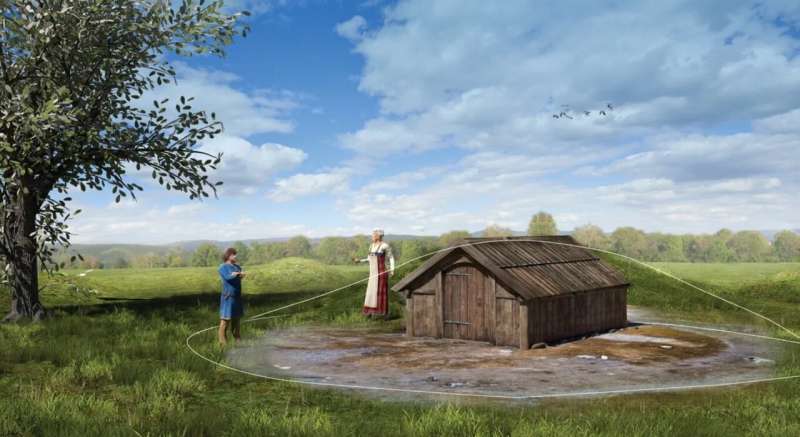August 26, 2024 feature
This article has been reviewed according to Science X's editorial process and policies. Editors have highlighted the following attributes while ensuring the content's credibility:
fact-checked
trusted source
proofread
Unique Iron- and Viking-age mortuary houses unearthed in Norway

Recent work published by Dr. Raymond Sauvage and Dr. Richard Macphail in Medieval Archaeology describes the excavation and interpretation of three Iron- and Viking-Age mortuary houses in central Norway, Skeiet, in the village of Vinjeøra.
The three structures date to between AD 500 and AD 950 and were likely part of funerary rituals that enabled the living to repeatedly visit and interact with the dead.
Between 2019 and 2020, the planned construction of a road necessitated excavations, which confirmed the existence of a pre-Christian cemetery, partially excavated in a test pit back in 1996. Surprisingly, alongside flattened burial mounds, three mortuary houses were discovered.
Mortuary houses, usually found within funerary contexts such as cemeteries, are multifaceted and could contain graves, tombs, or even be used to store the deceased's cremated remains. Some were also used as places where the living could leave offerings for the departed or worship their dead.
The mortuary houses found around Scandinavia may have served a similar purpose. However, unlike other mortuary houses, including 12 others from Norway and one in Sweden, those from Vinjeøra are unique in that they do not feature a permanent interment.
"I think that the most surprising thing was that we did not find any evidence of a permanent tomb or a buried person inside the houses. Also, the fact that they had doors and entrances that may have led into the mortuary house and burial mound was something I had not thought of prior to the analysis," says Dr. Sauvage.
The existence of doors and entrances suggested that the mortuary houses were permanently open so that the living could revisit the insides. The trampled soil that made up the entrance confirmed this, suggesting frequent visitation by the living. These entrances were low, and individuals would have had to crouch to reach the inside.
According to Dr. Sauvage this was not unusual, "Based on the relationship between the size of the mound and the plan of the house, we must assume that one would have to crouch. The room inside must have been quite small and dark, while the door must have let in some light that illuminated parts of the interior. Most of the mortuary houses that I know of are of similar size."
Based on the dates obtained from the mortuary houses, the first structure had been erected in AD 450–600, during the Iron Age. During this time, cemetery practice used cremation as the primary form of interment. Later, a second structure was built, around AD 600–800, just as the cemetery began transitioning to more frequent inhumations. Finally, the third mortuary house was constructed between AD 800 to mid or late AD 900 after cemetery practice had fully changed from cremation to inhumation.
Each structure was used for almost 100–200 years, suggesting that while the burial practices surrounding them may have changed, the mortuary houses remained a vital component of the rituals.
Dr. Sauvage elaborates on these changes as follows, "It seems to me that the burial practices seem to have been affected by a number of factors, such as influences from travel and contact and changing motivation behind what to amplify in the more public displays seen in burial rituals.
"The mortuary houses show a more stable continuity in use, probably related to the families' own tradition of venerating their deceased and ancestors. These rituals could have been more private and may have been more stable over time."
While no burials were recovered from the mortuary houses, other finds, such as fragments of bone, arrowheads, and nails, may help illuminate the structures' intended use.
The remains of a horse were identified among the bones. These may have been the result of a sacrificial killing akin to blót, a sacrificial ritual central to many Norse religious practices. The practice was often mentioned in both later and contemporary accounts of the old Norse religion and was usually linked to burial feasts and rituals.
Although evidence for the actual act of sacrificing does not exist, all the other animal bones found in the wall trenches do have evidence of burning. This may indicate they were cooked, perhaps as part of ritual meals linked to the dead or funerary rites.
This could harken back to the pre-modern tradition in Norway in which food and drink were left at burial mounds to be shared with the dead.
Similarly, the mortuary houses' construction akin to contemporary dwellings may link back to the idea that the deceased lived on in burial mounds.
However, because no burials were found within these mortuary houses, perhaps they could have stored the body as it was prepared for burial. This is similar to how 10th-century traveler Ibn Fadlan described the Norse burial ritual he witnessed in Rus territory. The body had to be stored in a wooden burial chamber for 10 days as food and grave goods were prepared.
The mortuary houses of Norway are still very enigmatic and more research will be needed to truly understand their function.
"Future studies should focus more on the interior to get better data about their use. Our evidence was fragmented, and there are several unanswered questions such as how the interior looked, whether there was a designated space to lay out the body, and how the entrances looked.
"Also, we should try to get a better understanding about their relationship to the burial mounds. Can we recover stratigraphic evidence that proves they were covered by the mound, or was the mound built as a later installment?"
More information: Raymond Sauvage et al, Ritual Practice at Late Iron-Age and Viking-Age Cemeteries in Norway: The Mortuary Houses From Skeiet, Vinjeøra, Medieval Archaeology (2024). DOI: 10.1080/00766097.2024.2347753
© 2024 Science X Network





















